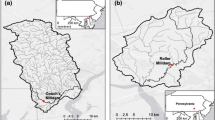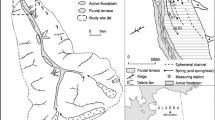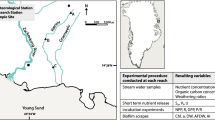Abstract
Hyporheic exchange is important in increasing stream water transit time through basins and enhancing redox-sensitive biogeochemical reactions influencing downstream water quality. Such exchange may be enhanced by beaver dams which are common throughout low order streams including those originating in peatlands. To understand the influence of beaver dams on hyporheic flows and biogeochemical properties, nitrogen (N), dissolved organic nitrogen (DOC) and N cycling rates were observed along a beaver dammed, third-order stream draining Canadian Rocky Mountain peatland. Beaver dams enlarged the hyporheric zone from ≤1.5 to ≥7.5 m. The looping hyporheic flow path created a zone of N and DOC depletion adjacent to the dams. As a result, nitrification rates were lowest in this zone. Where hyporheic flows exited the riparian area and flowed back to the stream channel downstream of a dam, the adjacent riparian area served as a source of N and DOC to the stream. Enhanced nutrient influx to streams owing to beaver dam modified hyporheic flow paths has implications for stream biogeochemical cycling and ecological integrity, which need further exploration.









Similar content being viewed by others
References
Allan C, Vidon P, Lowrance R (2008) Frontiers in riparian zone research in the 21st century. Hydrological Processes 22:3221–3222
Battin TJ, Kaplan LA, Findlay S, Hopkinson CS, Marti E, Packman AI, Newbold JD, Sabater F (2008) Biophysical controls on organic carbon fluxes in fluvial networks. Nature Geoscience 1:95–100
Bedard-Haughn A, Matson AL, Pennock DJ (2006) Land use effects on gross nitrogen mineralization, nitrification, and N2O emissions in ephemeral wetlands. Soil Biology and Biochemistry 38:3398–3406
Boano F, Demaria A, Revelli R, Ridolfi L (2010) Biogeochemical zonation due to intrameander hyporheic flow. Water Resources Research 46. https://doi.org/10.1029/2008WR007583
Briggs MA, Lautz LK, Hare DK (2014) Residence time control on hot moments of net nitrate production and uptake in the hyporheic zone. Hydrological Processes 28:3741–3751
Chestnut TJ, McDowell WH (2000) C and N dynamics in the riparian and hyporheic zones of a tropical stream, Luquillo Mountains, Puerto Rico. Journal of the North American Benthological Society 19:199–214
Freeze RA, Cherry JA (1979) Groundwater. Prentice-Hall, Englewood Cliffs, p 604
Gomez-Velez JD, Harvey JW, Cardenas MB, Kiel B (2015) Denitrification in the Mississippi River network controlled by flow through river bedforms. Nature Geoscience 8:941–945. https://doi.org/10.1038/NGEO2567
Greenwald MJ, Bowden WB, Gooseff MN, Zarnetske JP, McNamara JP, Bradford JH, Brosten TR (2008) Hyporheic exchange and water chemistry of two arctic tundra streams of contrasting geomorphology. Journal of Geophysical Research – Biogeosciences 113(G02029):1–14
Gu C, Anderson W, Maggi F (2012) Riparian biogeochemical hot moments induced by stream fluctuations. Water Resources Research 48(W09546):1–17
Harms TK, Grimm NB (2008) Hot spots and hot moments of carbon and nitrogen dynamics in a semiarid riparian zone. Journal of Geophysical Research – Biogeosciences 113(G01020):1–14
Hart SC, Stark JM, Davidson EA, Firestone MK (1994) Nitrogen mineralization, immobilization, and nitrification. In: Weaver RW, Angle S, Bottomley P, Bezdiecek D, Smith S, Tabatabai A, Wollum A (eds) Methods of soil analysis: part 2—microbiological and biochemical properties book series no. 5. Soil Science Society of America, Madison, pp 985–1018
Hill AR, Duval TP (2009) Beaver dams along an agricultural stream in southern Ontario, Canada: their impact on riparian zone hydrology and nitrogen chemistry. Hydrological Processes 23:1324–1336
Hill AR, Lymburner DJ (1998) Hyporheic zone chemistry and stream-subsurface exchange in two groundwater-fed streams. Canadian Journal of Fisheries and Aquatic Sciences 55:495–506
Hill AR, Labadia CF, Sanmugadas K (1998) Hyporheic zone hydrology and nitrogen dynamics in relation to the streambed topography of a N-rich stream. Biogeochemistry 42:285–310
Hill AR, Vidon PG, Langat J (2004) Denitrification potential in relation to lithology in five headwater riparian zones. Journal of Environmental Quality 33:911–919
Janzen K, Westbrook CJ (2011) Hyporheic flows along a channelled peatland: influence of beaver dams. Canadian Water Resources Journal 36:331–347
Karran D, Westbrook CJ, Bedard-Haughn A (2018) Beaver-mediated water table dynamics in a Rocky Mountain fen. Ecohydrology 11(2):e1923
Lautz LK, Siegel DI (2006) Modeling surface and ground water mixing in the hyporheic zone using MODFLOW and MT3D. Advances in Water Resources 29:1618–1633
Lautz LK, Siegel DI, Bauer RL (2006) Impact of debris dams on hyporheic interaction along a semi-arid stream. Hydrological Processes 20:183–196
McClain ME, Boyer EW, Dent CL, Gergel SE, Grimm NB, Groffman PM, Hart SC, Harvey JW, Johnston CA, Mayorga E (2003) Biogeochemical hot spots and hot moments at the interface of terrestrial and aquatic ecosystems. Ecosystems 6:301–312
Meixner T, Huth A, Brooks PD, Conklin M, Grimm N, Bales R, Haas P, Petti J (2007) Influence of shifting flow paths on nitrogen concentrations during monsoon floods, San Pedro River, Arizona. Journal of geophysical research. Biogeosciences 112(G03S03):1–11
Merill L, Tonjes DJ (2014) A review of the hyporheic zone, stream restoration, and means to enhance denitrification. Critical Reviews in Environmental Science and Technology 44:2337–2379
Morrison A, Westbrook CJ, Bedard-Haughn A (2015) Distribution of Canadian Rocky Mountain wetlands impacted by beaver. Wetlands 35:95–104
Mulholland PJ, Helton AM, Poole GC, Hall RO, Hamilton SK, Peterson BJ, Tank JL, Ashkenas LR, Cooper LW, Dahm CN (2008) Stream denitrification across biomes and its response to anthropogenic nitrate loading. Nature 452:202–205
Paré MC, Bedard-Haughn A (2013) Soil organic matter quality influences mineralization and GHG emissions in cryosols: a field-based study of sub-to high Arctic. Global Change Biology 19:1126–1140
Pinay G, O'Keefe TC, Edwards RT, Naiman RJ (2009) Nitrate removal in the hyporheic zone of a salmon river in Alaska. River Research and Applications 25:367–375
Poole G, O'Daniel S, Jones K, Woessner W, Bernhardt E, Helton A, Stanford J, Boer B, Beechie T (2008) Hydrologic spiralling: the role of multiple interactive flow paths in stream ecosystems. River Research and Applications 24:1018–1031
Rode M, Hartwig M, Wagenschein D, Kebede T, Borchardt D (2015) The importance of Hyporheic zone processes on ecological functioning and solute transport of streams and rivers. Springer, Ecosystem Services and River Basin Ecohydrology, pp 57–82
Sklash M (1990) Environmental isotope studies of storm and snowmelt runoff generation. In: Anderson MG, Burt TP (eds) Process studies in hillslope hydrology. Wiley, Chichester, pp 401–435
Sponseller RA (2007) Precipitation pulses and soil CO2 flux in a Sonoran Desert ecosystem. Global Change Biology 13:426–436
Triska FJ, Kennedy VC, Avanzino RJ, Zellweger GW, Bencala KE (1989) Retention and transport of nutrients in a third-order stream in northwestern California: Hyporheic processes. Ecology 70:1893–1905
Triska FJ, Duff JH, Avanzino RJ (1993) The role of water exchange between a stream channel and its hyporheic zone in nitrogen cycling at the terrestrial-aquatic interface. Hydrobiologia 251(1):167–184
Trotter EH (1990) Woody debris, forest-stream succession, and catchment geomorphology. Journal of the North American Benthological Society 9:141–156
Vidon P, Allan C, Burns D, Duval TP, Gurwick N, Inamdar S, Lowrance R, Okay J, Scott D, Sebestyen S (2010) Hot spots and hot moments in riparian zones: potential for improved water quality management1. J Am Water Resour Assoc 46(2):278–298
Wagner BJ, Bencala KE (1996) Evaluating the reliability of the stream tracer approach to characterize stream-subsurfaCe water exchange, “Judson W. Harvey” A k 9. Water Resources Research 32:2441–2451
Wang X, Westbrook C, Bedard-Haughn A (2016) Effect of mineral horizons on spatial distribution of soil properties and N cycling in a mountain peatland. Geoderma 273:73–82
Wang X, Siciliano S, Helgason B, Bedard-Haughn A (2017) Responses of a mountain peatland to increasing temperature: a microcosm study of greenhouse gas emissions and microbial community dynamics. Soil Biology and Biochemistry 110:22–33
Ward AS (2016) The evolution and state of interdisciplinary hyporheic research. Wiley Interdisciplinary Reviews Water 3:83–103
Westbrook CJ, Bedard-Haughn A (2016) Sibbald research wetland: mountain peatland form and ecohydrologic function as influenced by beaver. The Forestry Chronicle 92:37–38
Westbrook CJ, Devito K (2004) Gross nitrogen transformations in soils from uncut and cut boreal upland and peatland coniferous forest stands. Biogeochemistry 68:33–50
Westbrook CJ, Cooper DJ, Baker BW (2006) Beaver dams and overbank floods influence groundwater–surface water interactions of a Rocky Mountain riparian area. Water Resources Research 42(W06404):1–12
Wheater CP, Cook PA (2000) Using statistics to understand the environment. Psychology Press, Routledge, Hamshire
Williams MR, Buda AR, Elliott HA, Hamlett J, Boyer EW, Schmidt JP (2014) Groundwater flow path dynamics and nitrogen transport potential in the riparian zone of an agricultural headwater catchment. Journal of Hydrology 511:870–879
Wondzell SM (2006) Effect of morphology and discharge on hyporheic exchange flows in two small streams in the Cascade Mountains of Oregon, USA. Hydrological Processes 20:267–287
Zarnetske JP, Haggerty R, Wondzell SM, Baker MA (2011) Dynamics of nitrate production and removal as a function of residence time in the hyporheic zone. Journal of Geophysical Research – Biogeosciences 116(G01025):1–12
Zarnetske JP, Haggerty R, Wondzell SM, Bokil VA, González-Pinzón R (2012) Coupled transport and reaction kinetics control the nitrate source-sink function of hyporheic zones. Water Resources Research 48(W11508):1–15
Acknowlegements
This work was funded by Natural Science and Engineering Research Council of Canada (NSERC) Discovery Grants to ABH (RGPIN#327645–2012) and CJW (RGPIN32827–2012), a University of Saskatchewan New Faculty award to CJW, a grant from the Global Institute for Water Security to ABH and CJW (CERC#214685), and scholarships from NSERC Canada Graduate Scholarship and the University of Saskatchewan to ES. We thank Larisa Barber, Ashley Mahaffey, Kim Janzen, May Guan and Adam Minke for field assistance and the University of Calgary Biogeosciences Institute for logistical support.
Author information
Authors and Affiliations
Corresponding author
Electronic supplementary material
ESM 1
(DOCX 597 kb)
Rights and permissions
About this article
Cite this article
Wang, X., Shaw, E.L., Westbrook, C.J. et al. Beaver Dams Induce Hyporheic and Biogeochemical Changes in Riparian Areas in a Mountain Peatland. Wetlands 38, 1017–1032 (2018). https://doi.org/10.1007/s13157-018-1059-9
Received:
Accepted:
Published:
Issue Date:
DOI: https://doi.org/10.1007/s13157-018-1059-9




